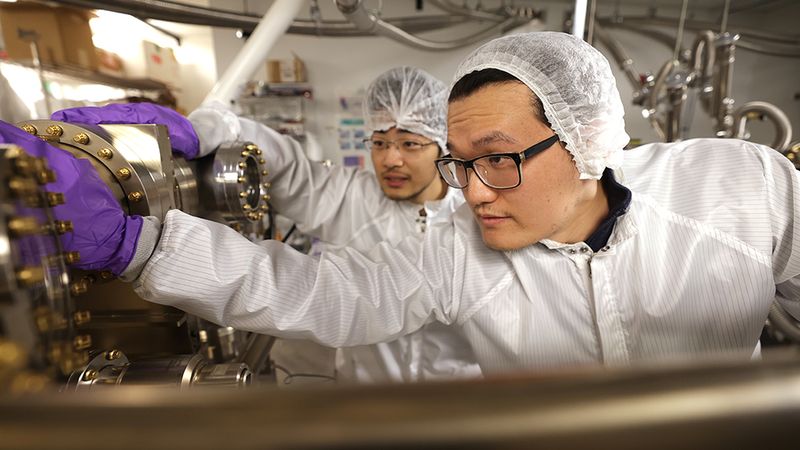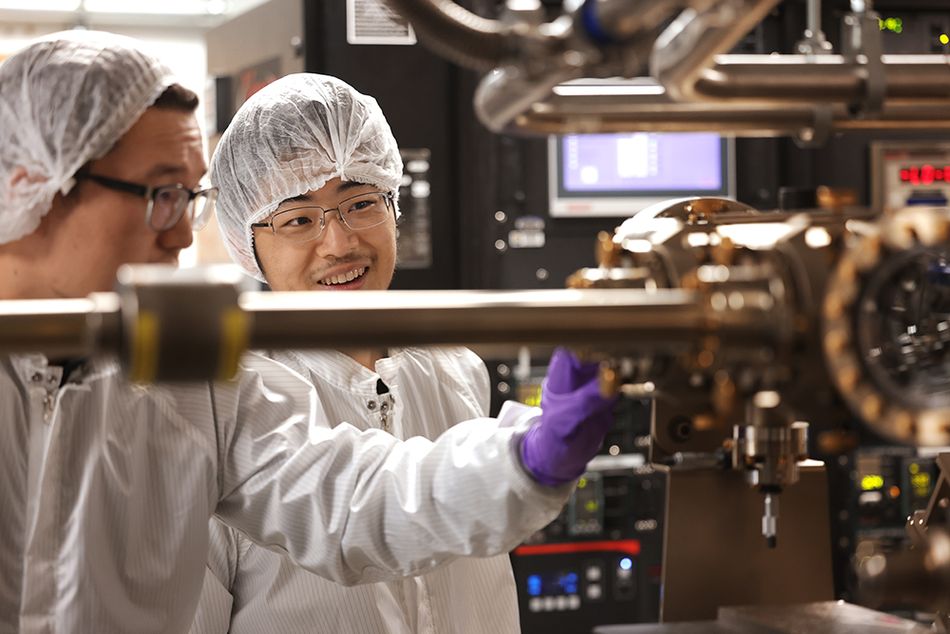Breakthrough in green micro-LEDs for augmented-mixed reality devices
Prof. Zetian Mi’s team are the first to achieve high-performance, highly stable green micro-LEDs with dimensions less than 1 micrometer on silicon, which can support ultrahigh-resolution full-color displays and other applications.

Yuanpeng Wu, right, a postdoctoral research fellow, and Yixin Xiao, a PhD student, both in ECE, and members of Professor Zetian Mi’s research group, working in the molecular beam epitaxy lab in the EECS Building on the North Campus of the University of Michigan. In the lab they are growing Indium gallium nitride (InGaN) nanowire micro-LEDs using molecular beam epitaxy. Photo: Brenda Ahearn/College of Engineering
Building on their groundbreaking work for highly-efficient red micro light emitting diodes (LEDs), Prof. Zetian Mi’s research team have now achieved a new approach for the design, fabrication, and integration of high-performance green micro-LEDs on silicon. These highly stable micro-LEDs are important for a broad range of applications in on-chip optical communication, including emerging augmented reality/mixed reality devices, and ultrahigh-resolution full-color displays.
“It’s very important to have a stable emission of all three colors – red, green, and blue – to achieve a high-quality display,” Mi said. “And it’s especially important to grow these small, stable LEDs directly on the silicon wafer for the future manufacturing and integration process.”
LEDs, which are typically stacks of semiconductor thin films, have already revolutionized the lighting and display world. They are far superior in efficiency, stability, and device volume compared to traditional devices, such as incandescent light bulbs and cathode tubes.
However, LEDs have many limitations when it comes to supporting virtual and augmented reality, as well as other emerging optoelectronic applications. These new applications demand micrometer or smaller LEDs that are highly stable, highly efficient, have ultralow power consumption, and can support full-color emission and brightness. In other words, they need to be one million times smaller than conventional broad area devices without sacrificing their quality.
Mi’s team recently succeeded in creating red micro-LEDs that are nearly three orders of magnitude smaller in surface area than previously reported devices while exhibiting external quantum efficiency of ~1.2%, but green micro-LEDs come with their own challenges.

“You can make very efficient large-area blue LEDs and large area red LEDs, but it is extremely difficult to make very efficient large area green LEDs. This is called the ‘Green Gap,’” Mi said. “But shrinking a device’s dimension to about one micrometer is extremely challenging whether it’s green or red.”
In addition, it’s important for these micro- and submicron-LEDs to be grown on silicon, instead of the traditional sapphire wafer. Silicon wafers improve the manufacturing process, allow for improved scalability and integration with small electronics, and are more cost-efficient. Specifically, they’re more suitable for integration with complementary metal-oxide-semiconductor (CMOS) electronics, which would pave the way for much more powerful photonic circuits. But using silicon also creates a mismatch in the lattice parameter, for the crystal structure is different.
To address these challenges, Mi’s team developed III-nitride submicron-scale green micro-LEDs using arrays of nanowires, each of which is only 100-200 nm in diameter and tens of nanometers apart.

“We use the nanowire structure to filter out the threading dislocations caused by lattice mismatch between the nitride materials and the silicon substrate,” said Yuanpeng Wu, a postdoc in Mi’s group and first author on the paper.
The result is the first high-performance, highly stable green micro-LEDs grown on silicon. They plan to apply the same sort of process for blue micro-LEDs.
“The approach we developed for green readily applies to blue,” Mi said. “The next step is integrating directly on the silicon wafer without transferring, which would be a huge improvement for manufacturing.”
With red, green, and blue micro-LEDs, the future of next-generation display technology begins.
The research is detailed in “InGaN micro-light-emitting diodes monolithically grown on Si: achieving ultra-stable operation through polarization and strain engineering” by Yuanpeng Wu, Yixin Xiao, Ishtiaque Navid, Kai Sun, Yakshita Malhotra, Ping Wang, Ding Wang, Yuanxiang Xu, Ayush Pandey, Maddaka Reddeppa, Walter Shin, Jiangnan Liu, Jungwook Min, and Zetian Mi, Light Science & Application, October 2022.
Fabrication work was accomplished in the Lurie Nanofabrication Facility, and technical support was provided by the Michigan Center for Materials Characterization.
Some intellectual property related to GaN-based nanowires was licensed to NS Nanotech Inc., which was co-founded by Mi. The University of Michigan and Mi have a financial interest in NS Nanotech, Inc.